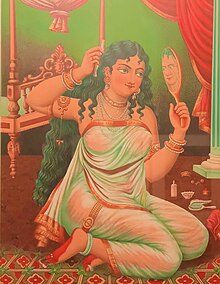
Sundari paintings or Sundari images are a type of pin-up or erotic art that were popular in 19th-century Calcutta, in the province of Bengal in British India.[1][2] Mostly sold as prints, the images depict women, particularly the new class of widows who took up sex work to survive, and are valuable references to understand the position of women in a society that was undergoing drastic shifts.[3]
Each Sundari, literally meaning 'beautiful woman', had a peculiar characteristic, such as playing the tabla, preparing paan, tuning the violin, or posing enticingly with roses.[3] Sundari images depict 19th-century Bengali woman who had to occupy the conflicted identity position of the widow and the courtesan, owing to the series of socio-political disruptions happening during the period.[3] The paintings provide a commentary on the larger social phenomenon of widowhood, that forced women into prostitution, which became prevalent during the nineteenth and twentieth centuries in Bengal post the abolition of sati.[1][2]
- ^ a b The Babu & the Bazaar: Art from the 19th & Early 20th–Century Bengal. Aditi Nath Sharkar, with Shatadeep Maitra. DAG Pvt. Ltd., New Delhi, 2022. ISBN 978-93-81217-90-0.
- ^ a b "The Babu and the Bazaar". dagworld.com. Retrieved 14 June 2023.
- ^ a b c Lakshmi, Rama (29 May 2023). "Between the brothel and Brindavan—Bengal art shows twin faces of Hindu widows after sati ban". ThePrint. Retrieved 14 June 2023.
© MMXXIII Rich X Search. We shall prevail. All rights reserved. Rich X Search
